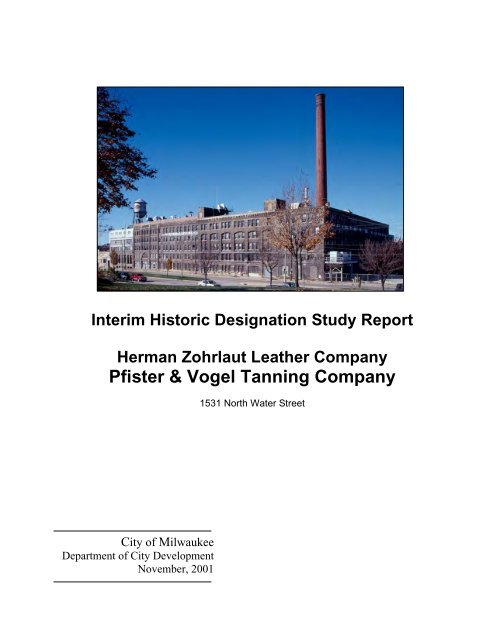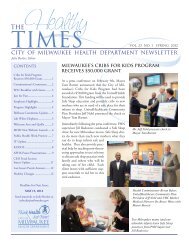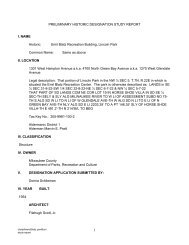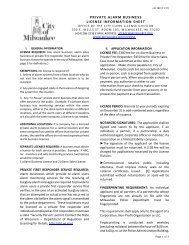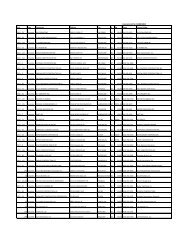Pfister & Vogel Tanning Company - City of Milwaukee
Pfister & Vogel Tanning Company - City of Milwaukee
Pfister & Vogel Tanning Company - City of Milwaukee
Create successful ePaper yourself
Turn your PDF publications into a flip-book with our unique Google optimized e-Paper software.
Interim Historic Designation Study Report<br />
Herman Zohrlaut Leather <strong>Company</strong><br />
<strong>Pfister</strong> & <strong>Vogel</strong> <strong>Tanning</strong> <strong>Company</strong><br />
<strong>City</strong> <strong>of</strong> <strong>Milwaukee</strong><br />
Department <strong>of</strong> <strong>City</strong> Development<br />
November, 2001<br />
1531 North Water Street
I. NAME<br />
INTERIM HISTORIC DESIGNATION STUDY REPORT<br />
Zohrlaut Leather <strong>Company</strong> Complex<br />
<strong>Pfister</strong> & <strong>Vogel</strong> <strong>Tanning</strong> <strong>Company</strong> Complex<br />
Historic: Herman Zohrlaut Leather <strong>Company</strong> / <strong>Pfister</strong> & <strong>Vogel</strong> <strong>Tanning</strong> <strong>Company</strong><br />
Common Name: <strong>Pfister</strong> & <strong>Vogel</strong> Tannery<br />
II. LOCATION<br />
Address: 1531 North Water Street<br />
Legal description: Fractional West ½ <strong>of</strong> SW ¼ SEC 21-7-22 or GAMMON FLOAT<br />
Block 123 ALL BLK 123 & Part LOTS 24 & 25 BLK F HATHAWAY’S<br />
SUBD ADJ LYING S OF HI-WAY EASM’T & (ALL BLK 123 EXC ST<br />
& ALL VAC E LYON ST ADJ & LOTS 1-2-3 & NE ½ LOT 4 EXC<br />
ST IN BLK 144) PARTITION OF SE FRACTION OF SEC NO 20-7-22<br />
ADJ Bid #121<br />
Aldermanic District: 3rd Aldermanic District, Alderman Michael S. D’Amato<br />
Tax Key No: 392-1818-112-4<br />
III. CLASSIFICATION<br />
Structure<br />
IV. OWNER<br />
Barry Mandel<br />
The Mandel Group<br />
111 East Wisconsin Avenue<br />
<strong>Milwaukee</strong>, WI 53202<br />
V. YEAR BUILT:<br />
1880’s – 1890’s 1<br />
ARCHITECT:<br />
C. F. Ringer 2<br />
Ferry & Clas 3<br />
1 <strong>City</strong> <strong>of</strong> <strong>Milwaukee</strong> Building Permits, various years<br />
2 <strong>City</strong> <strong>of</strong> <strong>Milwaukee</strong> Building Permits 1509-99 North Water St. #99, February 28, 1891 and #151, September 23, 1891<br />
3 Ibid. #2426, September 18, 1895, # 553, August 22, 1896 and #3568, October 28, 1897<br />
chatal/word/zohrlaut/pfister & vogel<br />
study report<br />
1
VI. PHYSICAL DESCRIPTION<br />
The Zohrlaut Leather <strong>Company</strong> complex / <strong>Pfister</strong> & <strong>Vogel</strong> <strong>Tanning</strong> complex is a grouping <strong>of</strong><br />
late nineteenth and twentieth century industrial buildings at the southwest corner <strong>of</strong> North<br />
Water and East Pleasant Streets. The area adjacent to the complex consists <strong>of</strong> a mix <strong>of</strong><br />
structures that reflect the area’s industrial past: former warehouses to the south, residential<br />
property to the east and up the hill from Water Street, scattered warehouse buildings and a<br />
former Trostel tannery building to the north along Water Street and a converted Schlitz<br />
Brewing <strong>Company</strong> building (now a medical complex) and new condominium complex across<br />
the river on the west bank.<br />
The Zohrlaut / <strong>Pfister</strong> & <strong>Vogel</strong> property is irregular in shape and lies along the east bank <strong>of</strong><br />
the <strong>Milwaukee</strong> River. There is over 800 feet <strong>of</strong> frontage along North Water Street as well as<br />
over 200 feet along East Pleasant Street. Most <strong>of</strong> the buildings fronting Water and Pleasant<br />
streets are five stories high with a few structures at one, two or three stories. All are built <strong>of</strong><br />
cream-colored brick and date from the 1880’s or 1890’s. They are built up to each other in a<br />
contiguous row and up to the lot line so there is no landscape treatment. To the south <strong>of</strong> this<br />
grouping and behind it are newer structures built from the 1930’s to the 1980’s. They are<br />
characterized by irregular form and red brick or metal cladding. An enormous water tank<br />
with the <strong>Pfister</strong> & <strong>Vogel</strong> trademark, a P and a V and the word Tannery set into an orange<br />
diamond, sits atop a portion <strong>of</strong> the factory built in 1967. Structures <strong>of</strong> varying heights and<br />
dimension can be found along the river edge <strong>of</strong> the property. These buildings were not given<br />
a “public face” and are utilitarian in character. They replaced the old wood frame storage<br />
and beam houses that had been the legacy <strong>of</strong> the Zohrlaut tannery. The north property line<br />
<strong>of</strong> the complex was once located fifteen feet from the curb line <strong>of</strong> East Pleasant Street where<br />
it approached a bridge across the <strong>Milwaukee</strong> River. In 1973 a new lift bridge replaced the<br />
old swing bridge and the roadway approach was realigned ninety feet further north. The<br />
tannery was able to acquire the abandoned right <strong>of</strong> way. The new open area was fenced in<br />
to provide for parking, loading and storage.<br />
Only the buildings dating to the 1880’s and 1890’s are being nominated for interim<br />
designation because <strong>of</strong> their cohesive scale, materials and fenestration patterns. The eight<br />
buildings are individually described below. Permit records do not exist for all <strong>of</strong> these<br />
buildings, but where specific construction data is missing, fire insurance maps have been<br />
able to provide approximate dates. The tremendous growth in the tanning industry between<br />
the 1880’s and World War I meant that the complex was not constructed according to any<br />
master plan, but the earliest frame buildings were replaced as needed by larger and more<br />
permanent and firepro<strong>of</strong> masonry buildings that were designed to show a prosperous and<br />
refined front to the public.<br />
The building now designated #2 in the complex (old address 809-813 N. Water St.) appears<br />
to have been the earliest brick building at the site and dates to the early 1880’s. It served as<br />
the <strong>of</strong>fice for the tannery. The architect is not known at this time. The five-story with<br />
basement, solid masonry, cream brick building has a façade divided into three bays. The<br />
centermost bay is emphasized by a slight projection from the main body <strong>of</strong> the building and a<br />
large two story round arch that frames what had once been the main entrance. This bay also<br />
features a trio <strong>of</strong> round-headed windows at the fifth story and ornamental cut stone impost<br />
blocks that are carved with ball-in-socket detail that is very characteristic <strong>of</strong> the 1880’s.<br />
Similar blocks are found at the piers to either end <strong>of</strong> the building. Cut stone forms the base<br />
<strong>of</strong> these two piers as well as the piers framing the center bay <strong>of</strong> the building. To either side<br />
<strong>of</strong> the large central arch on the first floor are large rectangular openings separated by<br />
chatal/word/zohrlaut/pfister & vogel<br />
study report<br />
2
decorative metal mullions. The first floor is set <strong>of</strong>f from the second story by both a brick and<br />
stone belt course between which runs a series <strong>of</strong> rectangular, recessed spandrels. Another<br />
belt course with corbelling sets <strong>of</strong>f the second story from the three floors above and groups<br />
the first two stories together to form a visual base for the building. Windows on floors two<br />
through five are uniform in size and feature segmental openings and four over four wood<br />
sash. The building is also capped <strong>of</strong>f with decorative corbelling. Alterations to the building<br />
include the closing up <strong>of</strong> windows on the first and second stories with either glass block or<br />
brick, reducing the size <strong>of</strong> the center entrance and alteration to the parapet. Historic<br />
engravings show that a rectangular plaque framed by tourelles once projected from the<br />
center bay and that tourelles once decorated the ends <strong>of</strong> the building as well. These<br />
features reinforced the Romanesque style <strong>of</strong> the building. The ro<strong>of</strong> was raised four feet in<br />
1950 thus necessitating the removal/alteration <strong>of</strong> these parapet features. The new brick<br />
does not match the original. As mentioned above, the building originally housed the<br />
company <strong>of</strong>fices on the first floor, but the upper levels housed the shipping, finishing, stuffing<br />
and drying departments.<br />
The bark mill, now designated building #9 (old address 109 Pleasant St.), was built in 1891<br />
and designed by local architect C. F. Ringer. The cream brick building is a tall, one-story<br />
structure that has been enlarged at least two times. The building’s façade reads as two<br />
structures with a large modern rectangular opening on the west and a round arched opening<br />
on the east. While both have ornamental corbelled cornices featuring Gothic arches, the<br />
parapet wall and ro<strong>of</strong> on the east are slightly taller than the rest <strong>of</strong> the building. The west<br />
wall is right up against the riverbank and is clad in metal siding. The arched opening as well<br />
as various windows have been blocked up.<br />
Built around the same time is the leach house, now designated building # 8 (old address<br />
113-117 Pleasant St.). It is immediately adjacent to the bark mill. The original architect is<br />
not known at this time. Permit records show that the ro<strong>of</strong> was raised eleven feet in 1896 and<br />
that this $2,000 alteration was designed by Charles H. Stehling. Apparently the ro<strong>of</strong> was<br />
raised only on a portion <strong>of</strong> the building as the building façade reads as two structures today.<br />
Four over four wood sash windows are set in segmental openings on each floor and there is<br />
an ornamental corbelled cornice with Gothic arches.<br />
Another leach house, building # 7 (old address 119-125 Pleasant St.), is located immediately<br />
adjacent to the above-mentioned building. The large solid masonry structure was built in<br />
1891 for $6,000 according to the designs <strong>of</strong> C. F. Ringer. Permit records indicate that Ferry<br />
and Clas designed an additional story in 1895 and the building has five stories today. The<br />
façade is grouped into five bays with pairs <strong>of</strong> four over four wood sash set into segmental<br />
openings. The large lower story, actually encompassing a two-story space, features tall<br />
window openings and is set <strong>of</strong>f from the upper stories by a corbelled cornice. Many <strong>of</strong> these<br />
ground floor openings have been blocked up or altered. Fire insurance maps show this<br />
building to have housed leaching operations as well as shaving, finishing and drying.<br />
The boiler house, building #6 (old address 127-131-137 Pleasant St.) is located directly<br />
adjacent to the above mentioned leach house. The five-story solid masonry building<br />
features a large ground floor that actually encompasses an interior space that is taller than a<br />
single story. Fire insurance maps show this building to have been constructed between<br />
1888 and 1892. The ground story is treated as a base to the building and is embellished<br />
with a prominent gothic arched corbelled cornice framed by belt courses. The ground floor’s<br />
main elevation on Water Street contains three large arched openings that engravings show<br />
to have been an entrance flanked by large window openings. A series <strong>of</strong> large openings and<br />
chatal/word/zohrlaut/pfister & vogel<br />
study report<br />
3
smaller window openings continue around the corner along the Pleasant Street elevation.<br />
The three upper stories <strong>of</strong> the Water Street elevation are grouped into two bays <strong>of</strong> three<br />
windows each. The wood, four over four sash windows feature segmental openings and<br />
stone sills. The windows along the upper stories <strong>of</strong> the Pleasant Street elevation are<br />
grouped in pairs and distributed regularly across the façade to form five bays. They, too,<br />
have segmental openings. An ornamental corbelled cornice <strong>of</strong> round arch design crowns<br />
both facades. An immense tile chimney extends from the ro<strong>of</strong> <strong>of</strong> this building and old<br />
illustrations show that metal ventilators also were perched on the ro<strong>of</strong> at one time.<br />
Alterations to this building consist mainly <strong>of</strong> the closing up <strong>of</strong> the ground floor arched<br />
openings and some windows. A large metal platform holding transformers was constructed<br />
alongside the Pleasant Street façade in 1987. Fire insurance maps show that besides<br />
housing the boilers, the building was used historically for splitting, finishing and tacking.<br />
Building # 3 (old address 815-821 N. Water St.) was constructed sometime between 1888<br />
and 1894. It housed the chrome tannery as well as finishing, stuffing and drying operations.<br />
The five story with basement building has a façade divided into six bays with a tall ground<br />
floor marked by tall window openings. On the upper stories segmental windows are<br />
arranged in pairs except for the southernmost bay which has single windows. The window<br />
openings have segmental arches and the wooden sash have a four-over-four pr<strong>of</strong>ile. A<br />
corbelled cornice crowns the structure. Alterations include the blocking up <strong>of</strong> ground floor<br />
windows and the four-foot extension to the ro<strong>of</strong> that was built in 1950. The name <strong>Pfister</strong> &<br />
<strong>Vogel</strong> and the orange diamond trademark is painted in block letters across the façade <strong>of</strong> this<br />
building between the fourth and fifth story.<br />
Building # 5 (old address 823-831 N. Water St.) was constructed in 1896 at a cost <strong>of</strong><br />
$10,000. Ferry and Clas designed the five story solid masonry structure in the new<br />
commercial style which incorporated elements from a variety <strong>of</strong> sources like the running<br />
arcade from Romanesque and the penciled rustication from French design. Without the use<br />
<strong>of</strong> costly stone or sheet metal ornament, Ferry and Clas were able to lend an elegance to<br />
even this industrial building. The building’s fenestration is grouped into six bays by a series<br />
<strong>of</strong> projecting segmental arches that extend to the fourth story. The ground floor is given<br />
special emphasis by the penciled rustication which gives a horizontal emphasis to the<br />
building and which forms dramatic wedge-shaped voussoirs above each <strong>of</strong> the windows at<br />
that level. Emphasis is also given to the ground floor by use <strong>of</strong> a stone belt course that<br />
separates the ground from the second story. Windows are grouped into threes in the center<br />
four bays while pairs <strong>of</strong> windows can be found in the southernmost bay and single windows<br />
in the northernmost bay. The wood sash have four-over-four pr<strong>of</strong>iles. A second belt course<br />
with corbelling separates the fourth from the fifth story making the latter into an attic level that<br />
is crowned by a corbelled parapet. Square tower-like structures extend above the ro<strong>of</strong>line<br />
on the north and south ends <strong>of</strong> the building. Alterations include the closing up <strong>of</strong> windows in<br />
the towers, the addition <strong>of</strong> security bars across the windows in the northernmost bay, the<br />
addition <strong>of</strong> a metal roll-up door to the north ground floor opening and the enlarging <strong>of</strong> the<br />
opening and removal <strong>of</strong> the original three windows in the ground floor bay nearest the roll up<br />
door. Fire insurance maps show this building was used for pressing, blacking, bolting,<br />
setting and tacking.<br />
The second <strong>of</strong>fice building, now designated building # 1 (old address 801-807 N. Water St.)<br />
was built in 1897 and also designed by the firm <strong>of</strong> Ferry and Clas. The $10,000 edifice was<br />
designed to look like a tall one story building with small attic level, but actually housed two<br />
stories. Sorting took place on the second floor. This building replaced the <strong>of</strong>fice function<br />
once house next door in the Romanesque style building that had been constructed in the<br />
chatal/word/zohrlaut/pfister & vogel<br />
study report<br />
4
early 1880’s. Ferry and Clas were adept in designing stylish buildings and did not have to<br />
rely on the overlay <strong>of</strong> costly stone or metal to give the façade elegance. Here the use <strong>of</strong><br />
penciled rustication and prominent voussoirs create a simplified version <strong>of</strong> the Beaux Arts<br />
style, a style for which they were famous and which they utilized on the <strong>Milwaukee</strong> Central<br />
Library and Public Museum Building. For the Zohrlaut tannery the architects raised the<br />
ground floor above a basement level that has small windows at grade. The large ground<br />
floor openings are arranged into four bays by pairs <strong>of</strong> windows. Illustrations show that the<br />
entrance was once located in the southernmost bay. A new entrance was created next<br />
door when a small one-story addition was built to the south in 1945. A pair <strong>of</strong> windows was<br />
installed in the location where the original entry had been located. Other alterations include<br />
replacement windows on the ground story and the addition <strong>of</strong> another story in 1952. This<br />
last remodeling removed the original attic story and replaced it with a metal clad façade that<br />
features metal-framed ribbon windows.<br />
VII. SIGNIFICANCE<br />
The Herman Zohrlaut Leather <strong>Company</strong>/<strong>Pfister</strong> & <strong>Vogel</strong> <strong>Tanning</strong> <strong>Company</strong> complex at 1531<br />
N. Water Street is significant as an intact grouping <strong>of</strong> late nineteenth century industrial<br />
buildings associated with the once important tanning industry. Zohrlaut was a very<br />
prominent company and ranked with the Trostel and Gallun tanneries in any mention <strong>of</strong> the<br />
industry in local histories. The tannery’s association with the international industry giant,<br />
<strong>Pfister</strong> & <strong>Vogel</strong>, also makes the complex worthy <strong>of</strong> preservation. In operation from 1847 to<br />
2000, the <strong>Pfister</strong> & <strong>Vogel</strong> name has been inextricably linked with <strong>Milwaukee</strong>’s development<br />
and it was here rather than at the Menomonee Valley plant that the company last tanned<br />
leather. The Zohrlaut / <strong>Pfister</strong> & <strong>Vogel</strong> tannery is also one <strong>of</strong> the few remaining complexes<br />
from which we can interpret and comprehend the roll that the <strong>Milwaukee</strong> River once played<br />
in the industrial might <strong>of</strong> the city. It stands as a visual landmark at the corner <strong>of</strong> N. Water<br />
and E. Pleasant Streets.<br />
The Zohrlaut/<strong>Pfister</strong> & <strong>Vogel</strong> complex is also significant as a fine collection <strong>of</strong> well articulated<br />
late nineteenth industrial buildings designed by some <strong>of</strong> the city’s leading architectural firms<br />
including Ferry and Clas and C.F. Ringer.<br />
VIII. HISTORY<br />
<strong>Tanning</strong> in <strong>Milwaukee</strong><br />
“In no branch <strong>of</strong> industry is <strong>Milwaukee</strong> more prominent than she is in the manufacture <strong>of</strong> leather,<br />
although comparatively few citizens <strong>of</strong> <strong>Milwaukee</strong> are aware <strong>of</strong> the magnitude <strong>of</strong> the tanning<br />
industry <strong>of</strong> their city”. These words, written by tannery executive Henry Eskuche in 1892 for the<br />
publication <strong>Milwaukee</strong>’s Great Industries, ring true even today. 4 Although the great tanneries are<br />
now just a historic record in the city most residents have little recollection and less understanding<br />
<strong>of</strong> an industry that once employed thousands and shipped its product around the world.<br />
The convergence <strong>of</strong> a number <strong>of</strong> factors led to <strong>Milwaukee</strong>’s preeminence in tanning. The ready<br />
availability <strong>of</strong> tan bark, the access to good shipping and rail lines, abundant water supply along<br />
the Rock River Canal, <strong>Milwaukee</strong> River and in the Menomonee Valley, and the availability <strong>of</strong><br />
hides from local and regional meat packers were seized upon by the city’s German Americans<br />
4<br />
W.J. Anderson and Julius Bleyer, eds. <strong>Milwaukee</strong>’s Great Industries (<strong>Milwaukee</strong>:Association for the Advancement <strong>of</strong><br />
<strong>Milwaukee</strong>, 1892), p. 157.<br />
chatal/word/zohrlaut/pfister & vogel<br />
study report<br />
5
who developed the core <strong>of</strong> Wisconsin’s tanning industry here. Charles Schefft’s master’s thesis<br />
The <strong>Tanning</strong> Industry in Wisconsin; A History <strong>of</strong> its Frontier Origins and its Development outlines<br />
this development in detail. He does point out, however, that even though other ethnic groups are<br />
represented in the tanning field, the industry remained about 70 % German because the training<br />
and technical knowledge brought from the old country made them particularly successful in this<br />
field. Other communities in other states had similar German American populations and some <strong>of</strong><br />
the same natural resources but their immigrants did not venture into the costly enterprise <strong>of</strong><br />
tanning again pointing out the unique mix <strong>of</strong> people and resources that <strong>Milwaukee</strong> had to <strong>of</strong>fer.<br />
The <strong>Milwaukee</strong> immigrants also either came with start up capital or were able to accumulate<br />
capital in sufficient amounts to start up and sustain tanneries, some <strong>of</strong> which survived into the<br />
1990’s. 5<br />
By 1860 there were a total <strong>of</strong> nine tanneries in <strong>Milwaukee</strong> and the industry ranked eighth in<br />
production with $218,000. The number <strong>of</strong> tanneries grew to fifteen by the late1860’s and to<br />
thirty by 1870. By 1874 tanning had risen to third in importance to the city behind ironwork and<br />
clothing and would rank number two in the 1880’s, the period <strong>of</strong> greatest development. 6<br />
<strong>Tanning</strong> would retain this status for the next several decades behind steel products and<br />
meatpacking. 7 Important names in the local tanning industry included <strong>Pfister</strong> & <strong>Vogel</strong>,<br />
Wisconsin Leather <strong>Company</strong>, Albert Trostel & Sons, August Gallun, Herman Zohrlaut, Conrad<br />
Brothers, George Martin, Chris Anstedt, G. B. Vollhardts, William Gerhardt Becher and the<br />
Elkerts among others. In 1890 <strong>Milwaukee</strong>’s output <strong>of</strong> plain tanned leather was the largest in the<br />
world, with its closest rivals being Chicago, Allegheny, Pennsylvania, Louisville, San Francisco,<br />
Newark and Buffalo. 8 The types <strong>of</strong> leather produced also included a variety <strong>of</strong> glove leathers,<br />
patent leathers, sole leather, harness leather, fly net leather and split leather. Eskuche wrote<br />
that even “the cowboys and rancheros in Texas, New Mexico, and on the Plains, use leggings<br />
made from the products <strong>of</strong> <strong>Milwaukee</strong>’s tanneries. The large horse-collar factories in Chicago,<br />
St. Louis and St. Paul rely principally on <strong>Milwaukee</strong> for their supplies <strong>of</strong> collar leather, and the<br />
farmer’s horse, the southern mule, the fine Percheron teams <strong>of</strong> the brewers, as well as the<br />
stylish coach horses, are decked with harness, collars and fly-nets made out <strong>of</strong> the alwaysreliable<br />
<strong>Milwaukee</strong> leather.” 9 The largest <strong>of</strong> the tanneries even had stores or branch <strong>of</strong>fices in<br />
other cities throughout the U.S. Spin <strong>of</strong>f industries grew in abundance as well and included shoe<br />
and boot manufacturing, saddleries, harness makers and trunk manufacturers as well as<br />
garment manufacturers who utilized leather. As Eskuche wrote, “There is nothing like<br />
<strong>Milwaukee</strong> leather; and the tanners who built this enviable reputation for their fair city<br />
accomplished their aim without making much ado about it.” 10<br />
As mentioned above, the tanneries tended to cluster near sources <strong>of</strong> water and shipping. The<br />
north end <strong>of</strong> the Menomonee Valley at Walkers Point saw the giant tannery complex <strong>of</strong> the<br />
<strong>Pfister</strong> & <strong>Vogel</strong> Leather <strong>Company</strong>. Another large complex evolved at the mouth <strong>of</strong> the<br />
Kinnickinnic River at the north end <strong>of</strong> Bay View. The <strong>Milwaukee</strong> River saw the largest<br />
concentration <strong>of</strong> tanneries where numerous small factories jockeyed for space alongside<br />
lumberyards and coal yards and iron works and other businesses. Most <strong>of</strong> the <strong>Milwaukee</strong> River<br />
5<br />
Charles Ernest Schefft, “The <strong>Tanning</strong> Industry in Wisconsin. A History <strong>of</strong> its frontier Origins and its Development”<br />
(unpublished Master’s Thesis, University <strong>of</strong> Wisconsin, 1938), p.16.<br />
6<br />
Ibid., p. 37, 40.<br />
7<br />
Bayrd Still, <strong>Milwaukee</strong>. The History <strong>of</strong> a <strong>City</strong> (Madison, The State Historical Society <strong>of</strong> Wisconsin, 1948), p. 486.<br />
8<br />
John G. Gregory, editor, Southeastern Wisconsin: A History <strong>of</strong> Old <strong>Milwaukee</strong> County, Vol.I (Chicago: S. J. Clarke<br />
Publishing <strong>Company</strong>, 1932), p.354.<br />
9<br />
Anderson and Bleyer, p.157.<br />
10 Ibid.<br />
chatal/word/zohrlaut/pfister & vogel<br />
study report<br />
6
tanneries had smaller complexes, with many frame and a few brick buildings. Eventually the<br />
river frontage would be dominated by the impressive buildings erected by the Zohrlaut, Gallun<br />
and Trostel tanneries.<br />
By the late 1890’s the number <strong>of</strong> tanneries began to decline as smaller businesses were bought<br />
up by larger concerns or just went out <strong>of</strong> business. Output continued to increase, however. In<br />
1909 local tanneries were processing over two million hides and skins annually and the products<br />
<strong>of</strong> <strong>Milwaukee</strong>’s eleven tanneries was valued at $27,484,000. <strong>Milwaukee</strong> “was the queen tanning<br />
city <strong>of</strong> the world.” 11 The industry peaked during World War I and shortly thereafter when the<br />
values <strong>of</strong> its products rose to an all-time high <strong>of</strong> $60,000,000. The great demands <strong>of</strong> the war for<br />
leather harnesses, belting, and clothing however, declined dramatically in the years afterwards.<br />
Lifestyle changes brought about by the automobile and electric motors led to less need for<br />
leather. Shoes and boots were lighter weight as people walked less, there were fewer horses<br />
requiring harness and buggy leather, and belt driven machinery became a thing <strong>of</strong> the past.<br />
Serious competition from foreign markets and the manipulation <strong>of</strong> the leather market also led to<br />
declines in tanning throughout the US. By 1924 <strong>Milwaukee</strong>’s tanning fell to a value <strong>of</strong><br />
$47,000,000, then to $20,000,000 in 1929 and $16,818,235 by 1939. 12<br />
The post depression and post World War II era saw an even further decline in the local tanning<br />
industry. A few names like Gallun, <strong>Pfister</strong> & <strong>Vogel</strong> and Trostel survived, but much diminished<br />
from their heyday. Gallun survived as the sole US producer <strong>of</strong> calfskin, but it closed in the<br />
1980’s. Its complex, listed in the National Register <strong>of</strong> Historic Places, still stands in the 1700 and<br />
1800 blocks <strong>of</strong> N. Water Street. Its former <strong>of</strong>fice building has been converted into apartments<br />
while the remainder awaits redevelopment or demolition. The Trostel tannery once<br />
encompassed both banks <strong>of</strong> the <strong>Milwaukee</strong> River just north <strong>of</strong> the Zohrlaut. Its surviving tall<br />
building was embroiled in the battle over a state prison site and it was ultimately demolished in<br />
1992. One <strong>of</strong> its buildings in the Star Tannery complex on the east bank <strong>of</strong> the river, later known<br />
as the Northern Lights Building, still stands and is now used for <strong>of</strong>fices. <strong>Pfister</strong> & <strong>Vogel</strong> survived<br />
in the former Zohrlaut complex until 2000 before closing. Some smaller operations like General<br />
Split were once located in the near South Side area but relocated out <strong>of</strong> the city. Today, the<br />
tanning industry is only represented by the surviving buildings in the former industrial complexes<br />
that once sustained large numbers <strong>of</strong> <strong>Milwaukee</strong> residents.<br />
Herman Zohrlaut Leather <strong>Company</strong><br />
The core buildings being nominated for interim designation at 1531 North Water Street consist <strong>of</strong><br />
late nineteenth cream brick structures that were all constructed for the Herman Zohrlaut Leather<br />
<strong>Company</strong>. <strong>City</strong> directories show that the German-American Herman Zohrlaut began his tanning<br />
career as a clerk with the G. <strong>Pfister</strong> & Co. at their location on East Water Street. Published<br />
histories indicate that Zohrlaut started up his own tannery in March <strong>of</strong> 1857 as a feeder to his<br />
leather store on Water Street. 13 <strong>City</strong> directories show him in a brief partnership with Adolph M.<br />
Neymann in 1858 as Neymann & Zohrlaut, dealers in leather. Zohrlaut then went out on his<br />
own. The <strong>Milwaukee</strong> Press Club’s 1910 Commercial History <strong>of</strong> Wisconsin and the city<br />
directories indicate that he first produced collar, calf, kip, line, flynet and harness leather and<br />
then perfected “<strong>Milwaukee</strong> Oil Grain”. The tannery complex was described as a “cluster <strong>of</strong><br />
ramshackle sheds” at first, on the east bank <strong>of</strong> the <strong>Milwaukee</strong> River just south <strong>of</strong> the Pleasant<br />
Street Bridge where it is today. As the tanning part <strong>of</strong> the business prospered the store was<br />
11 Schefft, p.77.<br />
12 Still p. 494.<br />
13 <strong>Milwaukee</strong> Press Club, editors, Commercial History <strong>of</strong> Wisconsin (<strong>Milwaukee</strong>: Thompson H. Adams, 1910), p.89.<br />
chatal/word/zohrlaut/pfister & vogel<br />
study report<br />
7
dropped and the industrial complex was expanded almost continually. Herman’s son Edward<br />
was brought into the business in the early 1870’s. The Zohrlaut family, including son Edward<br />
and daughters Emily and Mary, initially lived on today’s West Wisconsin Avenue between 20 th<br />
and 21 st Streets. In 1875 Herman had a new Italianate mansion, designed by local architect<br />
Charles Gombert, constructed near to his plant at the northwest corner <strong>of</strong> Marshall and Pleasant<br />
Streets. He would live in this residence until retirement. 14<br />
Zohrlaut incorporated his business as the Herman Zohrlaut Leather <strong>Company</strong> on March 1, 1879<br />
with a capital stock <strong>of</strong> $100,000. The incorporators included Herman, his son Edward and his<br />
son-in-law, Henry Eskuche. Herman would serve as the first president <strong>of</strong> the company, with<br />
Rudolph Mengelberg as secretary and treasurer and director, and with Edward Zohrlaut as<br />
director. Edward would later serve as general manager and Henry Eskuche as secretary. By<br />
1881 the business employed 75 persons with an annual income <strong>of</strong> $28,000. Some 25,000 hides<br />
and 5,000 skins were processed at a value <strong>of</strong> $275,000 and 25,000 cords <strong>of</strong> tan bark used in the<br />
tanning process. The business’ capital was increased to $500,000 in 1891. By 1910 the<br />
company was processing some 1500 “packer” hides a day along with “country “ hides from Ohio,<br />
Michigan and Indiana. 15<br />
<strong>Milwaukee</strong> Sentinel articles show numerous construction projects at the tannery during the<br />
1880’s. On June 21, 1881 the paper noted that a four-story, 60-foot long brick building was<br />
under way and followed up on August 8, 1881 with a brief mention that the “Extensive additions<br />
<strong>of</strong> <strong>Pfister</strong> & <strong>Vogel</strong>, Herman Zoehrlaut {sic} and Trostel & Gallun marks a new era in the tanneries<br />
<strong>of</strong> <strong>Milwaukee</strong>” and now enabled the industry to employ 300 to 400 more workers.” 16 It was<br />
during this decade that prominent four and five story cream brick buildings began to be<br />
constructed along the Water Street frontage <strong>of</strong> the property in an attempt to keep up with<br />
business expansion and technological innovations and to present a prosperous dignified image<br />
to the public. The Herman Zohrlaut Leather <strong>Company</strong> would have been ranked below the giant<br />
<strong>Pfister</strong> & <strong>Vogel</strong> Leather <strong>Company</strong>, but at this time was comparable in size to the output <strong>of</strong><br />
tanneries like Trostel and Gallun.<br />
When Herman Zohrlaut retired in 1899 and was succeeded by his son Edward, the historic core<br />
buildings along Water and Pleasant Streets had all been built. The tannery compared favorably<br />
in its architectural design to other industrial complexes flanking the <strong>Milwaukee</strong> River. Nearby<br />
Schlitz Brewery underwent extensive development and expansion during this era with<br />
architecturally significant buildings clustered in the Brewers Hill neighborhood. Directly across<br />
the river from Zohrlaut and both north and south <strong>of</strong> the Pleasant Street swing bridge lay the<br />
extensive buildings and yards <strong>of</strong> the Schroeder Lumber <strong>Company</strong>. The Schroeder Buildings<br />
showed shaped gables and other embellishments derivative <strong>of</strong> German architecture. To the<br />
north <strong>of</strong> Zohrlaut and Schroeder along both banks <strong>of</strong> the river were numerous buildings <strong>of</strong> the<br />
Trostel Tannery. Further north in the 1700 and 1800 blocks <strong>of</strong> North Water Street was the<br />
complex <strong>of</strong> the Gallun Tannery. Trostel and Gallun employed towers, corbelled cornices and<br />
other embellishments to give their buildings prominence and utilized many <strong>of</strong> the same<br />
architectural firms as the Zohrlauts. Not much remains <strong>of</strong> this prosperous era. The Schroeder<br />
buildings have all been razed. The fate <strong>of</strong> the Trostel and Gallun tannery complexes has been<br />
cited above. All evidence <strong>of</strong> the smaller tanneries along the river has been erased long ago.<br />
14<br />
Ibid.; <strong>Milwaukee</strong> <strong>City</strong> Directory, various years; <strong>Milwaukee</strong> Sentinel, October 23, 1875, page 3 column 1.<br />
15<br />
<strong>Milwaukee</strong> Press Club, p. 89.<br />
16<br />
<strong>Milwaukee</strong> Sentinel, June 21, 1881, page 5 column 2.<br />
chatal/word/zohrlaut/pfister & vogel<br />
study report<br />
8
Edward Zohrlaut would pilot the company through generally prosperous times for the next 15 to<br />
16 years. Founder Herman Zohrlaut died in April, 1911 in Munich where he had spent his<br />
retirement years. 17 Later <strong>of</strong>ficers included D. Milton Jones (secretary 1905-1912), Nathan<br />
Pereles Jr. (vice-president), Frank B. Desmond (assistant secretary), and Edward Friedman<br />
(secretary). Perhaps age or health conditions prompted Edward Zohrlaut to sell his tannery or<br />
perhaps there were no heirs who wanted to continue the business. Nevertheless, the company<br />
was last listed in the city directories in 1914. It was subsequently purchased by the giant <strong>Pfister</strong><br />
& <strong>Vogel</strong> Leather <strong>Company</strong>. Edward Zohrlaut initially stayed on as the plant superintendent, but<br />
left by1920. After several years <strong>of</strong> apparent retirement Edward is listed in directories as a<br />
leather broker or dealer from 1924 to 1929 with <strong>of</strong>fices in the Metropolitan Block on today’s Old<br />
World Third Street. He apparently left <strong>Milwaukee</strong> after that time.<br />
The story <strong>of</strong> the Zohrlaut tannery complex now continues under its new ownership.<br />
<strong>Pfister</strong> & <strong>Vogel</strong> Leather <strong>Company</strong>, <strong>Pfister</strong> & <strong>Vogel</strong> <strong>Tanning</strong> <strong>Company</strong>.<br />
The <strong>Pfister</strong> & <strong>Vogel</strong> Leather <strong>Company</strong> was established by Guido <strong>Pfister</strong>, Frederick <strong>Vogel</strong> and<br />
J.F. Schoellkopf in June 1848. <strong>Pfister</strong> and <strong>Vogel</strong>, natives <strong>of</strong> Hechingen and Kirchheim<br />
respectively, in Wuertemberg, Germany worked for several years in the tannery <strong>of</strong> J. F.<br />
Schoellkopf in Buffalo, New York. Schoellkopf was a cousin <strong>of</strong> Frederick <strong>Vogel</strong>’s. The promise<br />
<strong>of</strong> unlimited development and a large German population in <strong>Milwaukee</strong> drew <strong>Pfister</strong> and <strong>Vogel</strong> to<br />
this city where they set up in the tannery business. <strong>Pfister</strong> was to manage the company and<br />
opened a leather goods store in September, 1847. <strong>Vogel</strong> was the tanner and established a<br />
factory on the south end <strong>of</strong> the Menomonee Valley near what is today’s South 6 th Street the<br />
following spring. Schoellkopf stayed in Buffalo, but put up the finances for the venture. The<br />
business was so successful that Schoellkopf was able to withdraw from the company in 1857.<br />
The tannery was formally incorporated as the <strong>Pfister</strong> & <strong>Vogel</strong> Leather <strong>Company</strong> in 1872 with a<br />
capitalization <strong>of</strong> $200,000. Incorporators included Guido <strong>Pfister</strong>, who became president,<br />
Frederick <strong>Vogel</strong> who became vice-president and general manager, and Gottlob Bossert who<br />
became secretary. 18<br />
Operations included not only the Menomonee Valley plant, but also a sawmill and tannery at<br />
Two Creeks in Manitowoc County. The latter was phased out in the early 1880’s and the former<br />
tannery buildings there were destroyed by fire in 1885. By this time the company was doing a<br />
national business and was the largest tannery west <strong>of</strong> the Allegheny Mountains. 19 Statistics<br />
show that in 1881 the company was processing 100,000 hides annually and the value <strong>of</strong> its<br />
product was $500,000. 20 By 1890 <strong>Pfister</strong> & <strong>Vogel</strong> was the largest in <strong>Milwaukee</strong> producing<br />
350,000 sides <strong>of</strong> upper and sole leather as well as 300,000 kip, calf and goatskins and<br />
employing between 600 and 700 men with a payroll <strong>of</strong> $400,000. 21 Just two years later<br />
<strong>Milwaukee</strong> <strong>of</strong> To-Day, The Cream <strong>City</strong> <strong>of</strong> the Lakes reported that the number <strong>of</strong> employees had<br />
grown to 750 with wages paid <strong>of</strong> $500,000 and hides processed at a value <strong>of</strong> $3,000,000. The<br />
write-up also indicated that the company had some 25 buildings devoted to the tanning<br />
process. 22 <strong>Pfister</strong> & <strong>Vogel</strong> dwarfed all its competition, but the three tanneries closest in<br />
17<br />
“Herman Zohrlaut is Dead”, April 16, 1911. Unidentified clipping in the collection <strong>of</strong> the <strong>Milwaukee</strong> County Historical<br />
Society.<br />
18<br />
<strong>Pfister</strong> & <strong>Vogel</strong> <strong>Tanning</strong> <strong>Company</strong>, 100 years <strong>of</strong> Service, N.P.,1948, p. 4,8.<br />
19<br />
Ibid.,p. 8.<br />
20<br />
{Frank A. Flower}, History <strong>of</strong> <strong>Milwaukee</strong>, Wisconsin, (Chicago: The Western Historical <strong>Company</strong>, 1881), p.1438.<br />
21<br />
Schefft, p. 51. Illustrated Description <strong>of</strong> <strong>Milwaukee</strong>, N.P., 1890, p.133.<br />
22<br />
<strong>Milwaukee</strong> <strong>of</strong> To-Day, The Cream <strong>City</strong> <strong>of</strong> the Lakes (<strong>Milwaukee</strong>: Phoenix Publishing <strong>Company</strong>, N.D. c. 1892-93), p.106<br />
chatal/word/zohrlaut/pfister & vogel<br />
study report<br />
9
production at this time were the Herman Zohrlaut Leather <strong>Company</strong>, A.F. Gallun and Son and<br />
the Albert Trostel <strong>Tanning</strong> <strong>Company</strong>. Each employed 150 men and produced over 100,000<br />
hides per year valued at $500,000. 23<br />
<strong>Pfister</strong> & <strong>Vogel</strong>’s expansion in the <strong>Milwaukee</strong> area was almost continuous throughout the 1880’s<br />
and 1890’s. The Menomonee Valley site was enlarged through land acquisitions in 1889,<br />
1891,1900 and 1904. The Cheboygan Tannery in Cheboygan, Michigan was acquired in 1895.<br />
In that same year the <strong>Pfister</strong> & <strong>Vogel</strong> Leather <strong>Company</strong> added the Bay View Tannery to its fold.<br />
It was located along the Kinnickinnic River at the north end <strong>of</strong> the Bay View community. By<br />
1896 there were sales branches in Boston, New York, London, North Hampton, Paris and Milan.<br />
By 1904 capitalization <strong>of</strong> the company stood at $4,500,000. 24<br />
It was in the years just prior to World War I that the company grew into the largest tannery in the<br />
world. It imported cowhides, calfskins, horsehides and goatskins from Europe, India, South<br />
America, China, Mexico, Africa and Australia and employed 2,400 employees with 31,200<br />
pieces handled daily. Its products were known by the names Boulevard, Cremore Horse, Lotus,<br />
Velour and Lotaline Calf; Lotus and Pevee kips and sides, Ski Grain, Farmuse, Velo Sides and<br />
Pevee Chrome Retan Sole or Nosoak Bends. 25 In response to the demand for leather from the<br />
Armed Forces, <strong>Pfister</strong> & <strong>Vogel</strong> purchased the Herman Zohrlaut Leather <strong>Company</strong> in 1916. As<br />
mentioned above, it is likely that the aging Edward Zohrlaut was no longer interested in<br />
maintaining the business and there appears to have been no heir wanting the tannery. Soon<br />
after purchase permit records from December 11, 1916 show that <strong>Pfister</strong> & <strong>Vogel</strong> spent $15,000<br />
to upgrade the Zohrlaut complex with a new yard building designed by Herman J. Esser. More<br />
new construction would follow in later decades.<br />
<strong>Company</strong> sales reached their peak in 1919 with an annual turnover <strong>of</strong> $34,447,614. At this time<br />
its capital stock had risen to $8,300,000 with surplus <strong>of</strong> $9,700,000. 26 The post World War I<br />
years saw a decline in the fortunes <strong>of</strong> <strong>Pfister</strong> & <strong>Vogel</strong> and the tanning industry as a whole. A<br />
company history cites government regulations, tariff charges, exporting hides to Europe and the<br />
fast European recovery and competition as factors in the decline while historians as Schefft and<br />
Still cite changing fashion, lifestyle and technology as factors in the declining need for leather<br />
products. <strong>Pfister</strong> & <strong>Vogel</strong> held on during the turbulent 1920’s, but when conditions did not<br />
stabilize, the company ceased tanning operations on December 31, 1930. Stock inventories<br />
were liquidated, and the factory complexes were converted into rental space for smaller<br />
businesses under the umbrella <strong>of</strong> the P & V Atlas Industrial Center, Inc. 27<br />
To utilize the expertise <strong>of</strong> its workforce and the experience <strong>of</strong> some <strong>of</strong> the supervisory staff,<br />
Charles P. <strong>Vogel</strong> established a new successor corporation in December, 1930 called the <strong>Pfister</strong><br />
& <strong>Vogel</strong> <strong>Tanning</strong> Co. The new corporation leased the buildings at Water and Pleasant Streets<br />
and began operations on January 1, 1931. It was able to purchase the complex from its<br />
predecessor company on November 2, 1932. Corporate <strong>of</strong>ficers included Charles P. <strong>Vogel</strong> as<br />
president, Frank Belz as vice-president and Stephen Pierson as secretary-treasurer. The plant<br />
had specialized in the Workshoe Elk line but gradually added other product lines throughout the<br />
1930’s. Its first trial order for Army leather was received in 1939 and beginning in 1942 almost<br />
23<br />
Schefft, p.51<br />
24<br />
Ibid., p.76. <strong>Pfister</strong> & <strong>Vogel</strong> , p. 8,9. R.H. Odell, compiler, Official Directory <strong>of</strong> the Corporations <strong>of</strong> <strong>Milwaukee</strong>,<br />
Wisconsin (<strong>Milwaukee</strong>: Odell & Owen, 1904), p. 159.<br />
25<br />
<strong>Pfister</strong> & <strong>Vogel</strong>, p. 9.<br />
26<br />
Ibid. p.11.<br />
27<br />
Ibid. p. 11,12.<br />
chatal/word/zohrlaut/pfister & vogel<br />
study report<br />
10
its entire production went into leather for the military. These efforts earned the employees an “E”<br />
award on November 24, 1944, especially deserved as the double shift operations were run by a<br />
force that averaged 52 ½ years in age. Products in 1948 included Elk, Ski-grain, Chrome-<br />
Waterpro<strong>of</strong>, Nimrod, Diana, Wiscona, Econo, Zenith, Juvenile, Pevee, Playshu, and <strong>Pfister</strong>-ski.<br />
Sales representatives were located in St. Louis, Missouri, Philadelphia, Pennsylvania, and<br />
Boston, Massachusetts. 28<br />
The <strong>Pfister</strong> & <strong>Vogel</strong> <strong>Tanning</strong> <strong>Company</strong> continually monitored costs and invested in changes in<br />
plant layout, machinery chemical controls and technological improvements during the 1930’s<br />
and 1940’s and was able to produce 66% more leather within the same plant in 1948 as it had<br />
during 1931. The company also boasted that it was among the first in its industry to provide<br />
vacation benefits for its employees, establish a formal plan <strong>of</strong> cash pr<strong>of</strong>it-sharing for all<br />
employees and set up a retirement trust for all employees. 29<br />
By 1950 Charles P. <strong>Vogel</strong> was still with the company and served as chairman <strong>of</strong> the board.<br />
Erhard Buettner was president, Stephen A. Pierson was vice-president-secretary, L.E. Meyers<br />
was vice-president in charge <strong>of</strong> production, and J. Kultgen was treasurer and assistant<br />
secretary. However, by 1960 Charles P. <strong>Vogel</strong> was no longer with the company and the long<br />
association <strong>of</strong> <strong>Pfister</strong> and <strong>Vogel</strong> family members had come to an end. Members <strong>of</strong> the <strong>Vogel</strong><br />
family did retain ownership <strong>of</strong> P & V Atlas with its complex at 6th and Virginia however, until<br />
1993 when they sold the buildings to developer Hans Moede. Moede has since demolished part<br />
<strong>of</strong> the complex and converted the remaining structures to <strong>of</strong>fices, apartments and artists’ l<strong>of</strong>ts.<br />
It was during the ownership <strong>of</strong> the <strong>Pfister</strong> & <strong>Vogel</strong> <strong>Tanning</strong> <strong>Company</strong> that much new<br />
construction was added to the Water Street complex. These efforts are documented in over<br />
1400 building permit records on the property. Most <strong>of</strong> the new buildings and additions are<br />
located to the rear or river side <strong>of</strong> the complex or to the south as the tannery expanded onto an<br />
old sand and gravel company site and the former property <strong>of</strong> the W. L. Wagner architectural iron<br />
works. These new buildings did not try to blend with the core <strong>of</strong> the complex, but also did not<br />
significantly alter them. Red brick and corrugated metal were the siding materials <strong>of</strong> choice for<br />
the new buildings. <strong>Pfister</strong> & <strong>Vogel</strong> made the first alteration in December 1916 when it hired<br />
Herman J. Esser to design a new yard building that cost $15,000. Later alterations occurred in<br />
the 1930’s with the construction <strong>of</strong> a sewage screen plant, dock wall, and various repairs and<br />
reinforcements to footings and floors and alterations to openings. Small additions and<br />
reconstructions and a garage followed in the 1940’s. New additions <strong>of</strong> varying sizes were<br />
almost continual during the 1950’s. The architectural firm <strong>of</strong> Eschweiler & Eschweiler did a<br />
majority <strong>of</strong> this work starting in the 1930’s and its successor firm would continue the working<br />
relationship through the 1960’s. Probably the most noticeable change to the footprint <strong>of</strong> the<br />
complex occurred in 1973. In that year the old Pleasant street swing bridge was replaced with<br />
the current lift bridge, a process that resulted in a realignment <strong>of</strong> Pleasant Street to a point 90<br />
feet further west. The tannery complex, once fifteen feet from the curb line, was now able to<br />
acquire a sizeable amount <strong>of</strong> land up to the new roadway. This area, enclosed with chain link<br />
fencing, allowed for the construction <strong>of</strong> a transformer platform and storage tanks alongside the<br />
building as well as provide for a parking lot. 30<br />
28<br />
Ibid., p.13-17.<br />
29<br />
Ibid., p.16.<br />
30<br />
Pleasant Street Bridge and Right <strong>of</strong> Way. Interview with Greg Rugalinski, <strong>City</strong> <strong>of</strong> <strong>Milwaukee</strong>, Department <strong>of</strong> Public<br />
Works. By Carlen Hatala November 8, 2001.<br />
chatal/word/zohrlaut/pfister & vogel<br />
study report<br />
11
The plant continued production at the Water Street facility until its closing in February, 2000. Its<br />
last owner, U. S. Leather, had acquired the facility in the 1990’s and produced finished leather<br />
for the auto industry, footwear, furniture and personal goods such as purses, apparel, hats and<br />
gloves and had plants in North Carolina, Nebraska, Canada and Indiana. The company was<br />
plagued with large losses and bankruptcy for a number <strong>of</strong> years before closing the <strong>Milwaukee</strong><br />
plant. The complex, including land on the north side <strong>of</strong> Pleasant Street, totaling 7.5 acres went<br />
up for sale in November, 2000. It recently (October, 2001) sold to <strong>Milwaukee</strong> developer Mandel<br />
Group, Inc. that plans to demolish the complex and build a mixed-use development including<br />
condominiums, apartments and retail. 31<br />
<strong>Milwaukee</strong> Cream Brick<br />
The Herman Zohrlaut / <strong>Pfister</strong> & <strong>Vogel</strong> tannery buildings are significant not only for their<br />
associations with the vibrant industrial activity once located along the <strong>Milwaukee</strong> River and their<br />
associations with the titan <strong>of</strong> the tanning industry, but also because they are among the rapidly<br />
dwindling number <strong>of</strong> structures made from <strong>Milwaukee</strong>’s unique cream-colored brick that is an<br />
inseparable part <strong>of</strong> the city’s history. In the late nineteenth century, the large number <strong>of</strong><br />
buildings in <strong>Milwaukee</strong> made from the impressive, golden-colored brick earned the city its<br />
“Cream <strong>City</strong>” nickname. Cream brick, however, began to fall out <strong>of</strong> favor by 1905 and has not<br />
been manufactured since the 1920’s making the remaining structures made <strong>of</strong> this material<br />
something <strong>of</strong> an endangered species. These buildings are an increasingly valuable part <strong>of</strong> the<br />
city’s architectural history and its civic pride.<br />
<strong>Milwaukee</strong>’s first brickyard opened for business in 1835 or 1836. The first brick makers thought<br />
that red brick would result after firing the red-brown <strong>Milwaukee</strong> clay, but an unusually high<br />
content <strong>of</strong> calcium and magnesium in the clay gave the brick a unique s<strong>of</strong>t yellow color instead.<br />
The cream brick, as it became known, grew in popularity in <strong>Milwaukee</strong> and the city’s brick<br />
makers took great pride in their unique product.<br />
In May <strong>of</strong> 1859 the schooner M.S.Scott sailed to Germany carrying, among other things,<br />
samples <strong>of</strong> <strong>Milwaukee</strong>’s cream brick to the mayor <strong>of</strong> Hamburg. The Germans were impressed<br />
with the <strong>Milwaukee</strong> brick and later imported some <strong>of</strong> it for use in ornamenting their new<br />
buildings. It is not known if there are any buildings surviving in Germany today that feature<br />
<strong>Milwaukee</strong> brick. There are buildings in other parts <strong>of</strong> this country that survive, notably the<br />
<strong>Milwaukee</strong> Building in Galena, Illinois that was constructed <strong>of</strong> our cream color brick. The<br />
popularity <strong>of</strong> <strong>Milwaukee</strong>’s cream brick was reflected by the fact that as late as the 1920’s, the<br />
Pittsburgh Paint and Glass Co., which was a large paint manufacturer in the east, sold a readymixed<br />
house paint in a creamy color called “<strong>Milwaukee</strong> brick.”<br />
The Architects<br />
Ferry and Clas<br />
31 “U.S. Leather seeks new start” Doris Hajewski, <strong>Milwaukee</strong> Journal Sentinel, December 21, 1997; “Retail Office Use<br />
planned for P & V”, Kelly Quigley, Business Journal, November 24, 2000<br />
chatal/word/zohrlaut/pfister & vogel<br />
study report<br />
12
The firm <strong>of</strong> Ferry and Clas was probably the most respected and talented <strong>of</strong> its day in<br />
<strong>Milwaukee</strong>. Not only did their work encompass such high-pr<strong>of</strong>ile major public buildings as<br />
today’s Central Library downtown, the State Historical Society (now Wisconsin Historical<br />
Society) Building in Madison and the Wisconsin Building at the Louisiana Purchase Exhibition,<br />
but extended to commercial and warehouse and even theater buildings. In addition, the firm<br />
designed scores <strong>of</strong> fine residences for well-to-do clientele throughout the state and had<br />
commissions from out-<strong>of</strong>-state clients. By the late 1890’s Ferry and Clas had established a<br />
reputation for elegant design and were much sought after as the prestigious architectural firm.<br />
George B. Ferry (February 7, 1851 – January 29, 1918) was born and educated in Springfield,<br />
Massachusetts, and studied architecture at the Massachusetts Institute <strong>of</strong> Technology in 1871<br />
and 1872 after which he began his architectural career in his hometown. A year following his<br />
1880 marriage to Springfield resident Cora Frances Phillips, Ferry moved to <strong>Milwaukee</strong> and<br />
established his practice. One <strong>of</strong> his prominent works during the 1880’s was the clubhouse for<br />
the Woman’s Club <strong>of</strong> Wisconsin on East Kilbourn Avenue. In 1890 Ferry went into partnership<br />
with Alfred C. Clas, and the two had <strong>of</strong>fices on Broadway between Wisconsin Avenue and<br />
Mason Street. During their partnership, which lasted until 1912, the two were responsible for<br />
many architectural projects. 32<br />
After the dissolution <strong>of</strong> the partnership with Clas, Ferry retained the <strong>of</strong>fices on Broadway and<br />
continued in practice until about 1916. Ferry was instrumental in organizing Wisconsin’s first<br />
architectural association, and was also a member <strong>of</strong> the organizational committee that framed<br />
the by-laws and constitution <strong>of</strong> the American Institute <strong>of</strong> Architects. He was chairman <strong>of</strong><br />
<strong>Milwaukee</strong>’s building code commission for four years, president <strong>of</strong> the <strong>Milwaukee</strong> Art<br />
Commission, and a member <strong>of</strong> the National Academy <strong>of</strong> Sciences. 33<br />
Throughout his life, Ferry lived at a variety <strong>of</strong> residences, on North 17 th Street, East Kilbourn<br />
Avenue, Farwell Avenue, Woodland Court, and Prospect Avenue. He last lived on Cambridge<br />
Avenue. 34 While his wife and daughter were away in New York, Ferry died at the residence <strong>of</strong><br />
his son, Robert P. Ferry, who was then living at 1502 East Royall Place. Ferry’s passing on<br />
Tuesday, January 29, 1918 was the result <strong>of</strong> grippe complicated by an infection <strong>of</strong> the heart.<br />
Upon his death, George B. Ferry was cited as an ideal architect, conscientious, extremely well<br />
educated, well-read, and artistic, and a pr<strong>of</strong>essional who was inspirational and helpful to<br />
younger members <strong>of</strong> the pr<strong>of</strong>ession. 35 His former partner, Alfred C. Clas, stated that Ferry<br />
“was one <strong>of</strong> the best designers ever in <strong>Milwaukee</strong>, an architect <strong>of</strong> exceptional good judgment<br />
and <strong>of</strong> very artistic temperment.” 36<br />
Alfred Charles Clas (December 26, 1859 – July 8, 1942) was born in Sauk <strong>City</strong>, Wisconsin, the<br />
son <strong>of</strong> German immigrants Adam and Magdalene (Ernst) Clas. He was educated in his<br />
hometown and after graduating from high school served a short-term appointment as a<br />
messenger boy in the State Senate. Clas subsequently apprenticed with an architect<br />
(unnamed) and also received two years <strong>of</strong> practical instruction in building construction. In<br />
1879 he went to Stockton, California and worked in an architect’s <strong>of</strong>fice there for almost two<br />
years. Clas then returned to Wisconsin and settled in <strong>Milwaukee</strong>. From about 1880 to 1884<br />
32<br />
George B. Ferry, Obituaries, Evening Wisconsin, January 29, 1918, page 1; <strong>Milwaukee</strong> Sentinel, Home Edition, January<br />
29, 1918, page 5; <strong>Milwaukee</strong> Journal, market edition, January 29, 1918, page 1.<br />
33<br />
Ibid.<br />
34<br />
Wright’s <strong>Milwaukee</strong> <strong>City</strong> Directory, 1881-1918<br />
35<br />
Ferry, Obituary, <strong>Milwaukee</strong> Journal.<br />
36<br />
Ferry, Obituary, Evening Wisconsin.<br />
chatal/word/zohrlaut/pfister & vogel<br />
study report<br />
13
he worked his way up from draftsman to architect in the <strong>of</strong>fices <strong>of</strong> James Douglas. From 1885<br />
to 1886 the two were in partnership, but Clas left in 1887 to set up his own architectural<br />
practice with <strong>of</strong>fices on <strong>Milwaukee</strong> Street. 37 Several years later Clas went into partnership with<br />
George B. Ferry who had been practicing in <strong>Milwaukee</strong> since 1881. The two carried on a very<br />
successful business from 1890 through 1912 and were responsible for a number <strong>of</strong> civic and<br />
institutional structures as well as residences: <strong>Milwaukee</strong> Public Library and Museum,<br />
Northwestern National Insurance Headquarters, the State Historical Society Library at<br />
Madison, St. John’s Cathedral Tower, the Matthews Brothers Building, the Y.W.C.A. Building,<br />
Buena Vista Flats, the <strong>Milwaukee</strong> Auditorium building, the Wisconsin State Building at the Pan-<br />
American Exposition in Buffalo, and the Wisconsin State Building for the St. Louis Exposition<br />
as well as the Forest Home Cemetery Chapel and the First Unitarian Church. Current<br />
research documents over two hundred projects executed by the firm.<br />
In the early decades <strong>of</strong> this century, Alfred Clas was very much involved with civic projects and<br />
took an active part in planning <strong>Milwaukee</strong>’s Civic Center, the beautification <strong>of</strong> the <strong>Milwaukee</strong><br />
River, and the development <strong>of</strong> Lincoln Memorial Drive and Parkway. He also laid out many <strong>of</strong><br />
the city’s boulevards, planned and supervised the construction <strong>of</strong> many <strong>of</strong> the city’s park<br />
buildings, and served on the <strong>City</strong> Board <strong>of</strong> Park Commissioners and the County Parks<br />
Commission, and served as president <strong>of</strong> the Metropolitan Park Commission. 38<br />
After dissolving his partnership with Ferry in 1912, Clas continued in partnership with his son<br />
Angelo Robert Clas from 1912 to 1921 and later with another son Rubens Frederick Clas and<br />
John S. Shepherd under the name Clas, Shepherd and Clas from 1921 until 1931. After<br />
Shepherd left, the firm became Clas and Clas once again. Their <strong>of</strong>fices had remained in the<br />
Colby-Abbot Building since 1914. Alfred Clas remained active in the practice into 1933 after<br />
which time a corporation was established, Clas and Clas, Inc. Clas apparently retired from<br />
active participation at that time although he served as president <strong>of</strong> the corporation through at<br />
least 1936. The corporation was continued under Rubens Clas into the 1940’s. Following his<br />
retirement, Clas and his second wife, Lucille, spent most <strong>of</strong> their time in Fort Lauderdale,<br />
Florida. After Lucille’s death in 1939, Clas made his home with his son, Rubens. His last year<br />
was spent at the Masonic Home in Dousman where he was under care for complications<br />
following a fall on the ice. Clas died <strong>of</strong> those complications on July 8, 1942 at the age <strong>of</strong> 82.<br />
Following Masonic funeral services at the Weiss Funeral Home on <strong>Milwaukee</strong>’s lower east<br />
side, Clas’ cremated remains were buried in Sauk <strong>City</strong>. 39<br />
The firm’s work for Herman Zohrlaut shows the finesse and detail that made them famous in<br />
their public and residential buildings. It also sheds light on what was probably a lucrative, but<br />
to us little known, part <strong>of</strong> their practice.<br />
Carl F. Ringer<br />
Carl F. Ringer, Sr. was born 1850/1851 in Germany and came to <strong>Milwaukee</strong> in 1870/1871. He<br />
was employed in the architectural firms <strong>of</strong> George Mygatt, Edward Townsend Mix and James<br />
37 John B. Gregory, History <strong>of</strong> <strong>Milwaukee</strong>, Wisconsin (<strong>Milwaukee</strong>: S. J. Clarke Publishing <strong>Company</strong>, 1931), Vol. III,<br />
p.188. Wright’s <strong>Milwaukee</strong> <strong>City</strong> Directory, 1880-1887; <strong>Milwaukee</strong>’s Leading Industries (New York: Historical<br />
Publishing <strong>Company</strong>, 1886), p. 142.<br />
38 Gregory, Vol. III, p. 191; Alfred Clas Obituary, <strong>Milwaukee</strong> Journal, Local News, July 8, 1942, p. 1; Alfred Clas<br />
Obituary, <strong>Milwaukee</strong> Sentinel, July 9, 1942, Sec. 1, p. 4.<br />
39 Wright’s <strong>Milwaukee</strong> <strong>City</strong> Directory, 1912-1942; Obituaries, <strong>Milwaukee</strong> Journal and <strong>Milwaukee</strong> Sentinel.<br />
chatal/word/zohrlaut/pfister & vogel<br />
study report<br />
14
Douglas before opening his own <strong>of</strong>fice in 1881. He quickly obtained some choice commissions<br />
from Adolph Meinecke, the <strong>Pfister</strong> & <strong>Vogel</strong> Leather <strong>Company</strong>, and various churches, among<br />
which was Zion Church at 21 st and North Avenue. Ringer was busy enough to employ several<br />
draftsmen by 1892. He was also known for superintending the construction <strong>of</strong> his designs. He<br />
had many clients among the German Americans <strong>of</strong> the city’s west side and designed dozens <strong>of</strong><br />
houses, most <strong>of</strong> which have been razed. One notable extant example is the Queen Anne style<br />
David W. Howie House (1886) on Wells Street now listed in the national Register <strong>of</strong> Historic<br />
Places. Ringer also designed a number <strong>of</strong> commercial buildings in the Third Ward and has<br />
industrial commissions as well. Later work included residential work on the lower east side such<br />
as the G. Frederick Bossert Double house at 2502 East Webster Place.<br />
In 1904 his son Carl F. Ringer, Jr., joined him in the practice and the firm became known as C.F.<br />
Ringer & Son. Carl, Sr. retired in 1934 but the younger Carl continued to work under the Ringer<br />
& Son name until his own death in 1938. Mayor Emil Seidel appointed Carl, Sr. as <strong>City</strong> Inspector<br />
in June 1911. After a conflict with later Mayor G. A. Bading over whether or not to raze a<br />
building, Ringer was fired. He went to court and the State Supreme Court ordered his<br />
reinstatement with full back pay. Ringer submitted his resignation that same day and was proud<br />
that the building he wanted rehabilitated was later repaired and used for many years thereafter.<br />
Ringer was a member <strong>of</strong> the Wisconsin Chapter <strong>of</strong> the American Institute <strong>of</strong> Architects, the<br />
<strong>Milwaukee</strong> Turnverein, and the Freie Gemeinde Society for which he designed the clubhouse on<br />
Fond du Lac Avenue that is locally designated. Ringer was involved in the establishment <strong>of</strong> the<br />
Badger Exploring <strong>Company</strong> and the <strong>Milwaukee</strong> Vinegar <strong>Company</strong> and also sat on the Harbor<br />
Commission and served as its vice-president. Ringer, Sr. died in April 1939 and was survived by<br />
two sons, Erwin and Adolph, and three sisters, on <strong>of</strong> whom was Mrs. Bertha Benz. She was the<br />
widow <strong>of</strong> German inventor Carl Benz, one <strong>of</strong> the designers <strong>of</strong> Mercedes-Benz.<br />
Ringer’s work on the Zohrlaut/<strong>Pfister</strong> & <strong>Vogel</strong> complex show him to be well versed in the<br />
industrial idioms <strong>of</strong> his day. He was apparently a much sought after designer and specialist in<br />
tannery buildings since he also did a lot <strong>of</strong> work at the Menomonee Valley/Walker’s Point tannery<br />
complex <strong>of</strong> <strong>Pfister</strong> & <strong>Vogel</strong>.<br />
chatal/word/zohrlaut/pfister & vogel<br />
study report<br />
15
REFERENCES<br />
Anderson, W.J. and Bleyer, Julius, eds. <strong>Milwaukee</strong>’s Great Industries. <strong>Milwaukee</strong>: Association<br />
for Advancement <strong>of</strong> <strong>Milwaukee</strong>. 1892.<br />
Evening Wisconsin. Various years.<br />
The Evening Wisconsin Newspaper Reference Book. <strong>Milwaukee</strong>: Evening Wisconsin <strong>Company</strong>,<br />
1914.<br />
[Flower, Frank A.]. History <strong>of</strong> <strong>Milwaukee</strong>, Wisconsin. Chicago: The Western Historical <strong>Company</strong>,<br />
1881.<br />
Gregory, John G. ed. History <strong>of</strong> <strong>Milwaukee</strong>, Wisconsin. 4 Vols. <strong>Milwaukee</strong>: S. J. Clarke<br />
Publishing <strong>Company</strong>, 1931.<br />
--------------------------- Southeastern Wisconsin: A History <strong>of</strong> Old <strong>Milwaukee</strong> County. 4 vols.<br />
Chicago: S.J. Clarke Publishing <strong>Company</strong>, 1932.<br />
“Herman Zohrlaut is Dead”. April 16, 1911. Unidentified clipping in the collection <strong>of</strong> the<br />
<strong>Milwaukee</strong> County Historical Society.<br />
Illustrated Description <strong>of</strong> <strong>Milwaukee</strong>. N.P. 1890.<br />
<strong>Milwaukee</strong> <strong>City</strong> Building Permits.<br />
<strong>Milwaukee</strong> <strong>City</strong> Directory.<br />
<strong>Milwaukee</strong> County Historical Society Library. Historic Photograph Collection.<br />
<strong>Milwaukee</strong> Journal. Various years<br />
<strong>Milwaukee</strong>’s Leading Industries. New York: Historical Publishing <strong>Company</strong>, 1886.<br />
<strong>Milwaukee</strong> <strong>of</strong> To-Day, The Cream <strong>City</strong> <strong>of</strong> the Lakes. <strong>Milwaukee</strong>: Phoenix Publishing <strong>Company</strong>,<br />
N.D. (c.1892-93)<br />
<strong>Milwaukee</strong> Press club ed. Commercial History <strong>of</strong> Wisconsin. <strong>Milwaukee</strong>: Thompson H. Adams,<br />
1910.<br />
Odell, R. H. compiler. Official Directory <strong>of</strong> the Corporations <strong>of</strong> <strong>Milwaukee</strong>, Wisconsin. <strong>Milwaukee</strong>:<br />
Odell & Owen, 1904.<br />
<strong>Pfister</strong> & <strong>Vogel</strong> <strong>Tanning</strong> <strong>Company</strong>. 100 Years <strong>of</strong> Service. N.P. 1948<br />
Pleasant Street Bridge and Right <strong>of</strong> Way. Interview with Greg Rugalinski, <strong>City</strong> <strong>of</strong> <strong>Milwaukee</strong><br />
Department <strong>of</strong> Public Works. November 8, 2001 by Carlen Hatala.<br />
Rasher’s Fire Insurance Map <strong>of</strong> the <strong>City</strong> <strong>of</strong> <strong>Milwaukee</strong>. Chicago: Rascher Fire Map Publishing<br />
<strong>Company</strong>, 1876 and 1888.
“Retail Office Use planned for P & V.” Kelly Quigley. Business Journal. November 24, 2000.<br />
Sanborn Insurance Maps <strong>of</strong> <strong>Milwaukee</strong>, Wisconsin. New York: Sanborn Map Co., 1894 and<br />
1910.<br />
Schefft, Charles Ernest. “The <strong>Tanning</strong> Industry in Wisconsin. A History <strong>of</strong> its Frontier Origins<br />
and its development.” Unpublished Master’s Thesis, University <strong>of</strong> Wisconsin, 1938.<br />
Still, Bayrd. <strong>Milwaukee</strong>. The History <strong>of</strong> a <strong>City</strong>. Madison: The State Historical Society <strong>of</strong><br />
Wisconsin, 1948.<br />
“U. S. Leather seeks new start.” Doris Hajewski. <strong>Milwaukee</strong> Journal Sentinel. December 21,<br />
1997.


